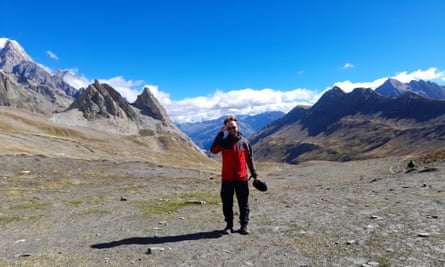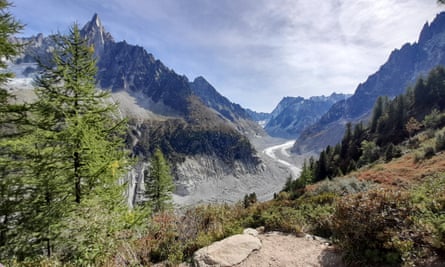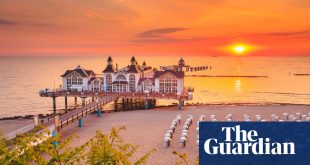It was the penultimate day of my Tour du Mont Blanc and, as I scrambled up the side of the Aiguilles de l’Argentière, I was feeling smug. I’d ticked off more than 90 of the 105 miles, almost all in dazzling spring sunshine. Such luck with the weather was encouraging complacency. But up high, any hubris is ripe for a humbling. And the mountain gods were beginning to conspire.
The first hint of trouble came when I recognised the two fellow hikers coming the other way. In Tré-le-Champ, way below, we had drunk coffee at neighbouring tables and, realising we were on the same route, resolved to move on to beer when we saw each other again at the next refuge, La Flégère. So when I saw them marching back to the village, I stopped, assumed a quizzical face and asked: Est-ce la bonne direction?
The second concern was that they were babbling, with eyes wide and urgent. Just an hour ago they had seemed calm and able to speak reasonable English. The third thing was the phrase one of them kept repeating: J’avais peur de mourir! I don’t speak much French, but this seemed a matter of mortal import.
An hour after deciding against following them down, I understood. The weather had become awful and, with my hood pulled low, I almost walked into a wall of rock. After a step back, I saw that progress demanded the ascent of three ladders, bolted into the cliff face but rusting under fierce elemental assault. Moving between the ladders required traversing metal platforms, each five feet long and the width of a walking boot. The guidebook had insisted the climb was no bother. Perhaps in fair weather. Just then the wind was lending a shoulder to the rain and battering every inch of my Gore-Tex.

A man was coming down the other way, practising an incantation: “Three points contact, three points contact.”
After an age he landed and sized me up while tucking loose straps into my bag. We spoke a little and he reassured me we had similar experience levels. Move one limb at a time and you’ll be fine, he said. All the rungs are stable and even. I knelt, breathed deep, and tied my laces in a double bow.
Halfway up, I started saying it: “Three points contact, three points contact.” I heaved a leg, then an arm, a leg, then an arm. After an eternity – there were more ladders beyond the first three – I hauled myself over the top. My heart rate was 170 beats a minute. This was the last-but-one day of an eight-day trek over high mountains and not once had it gone above 160.
The ladders were the last serious trial of a demanding itinerary. The route weaves across the mountaintop borders of France, Italy and Switzerland, with a total ascent exceeding the elevation of Mount Everest. More than once I had sympathy with middle-aged men, beached and breathless on top of a peak. Sleeping was a different challenge: nights were spent either wedged between snoring hippos in dorms or freezing under canvas.
Still, the scenery makes up for everything. On Mont Blanc, all is in motion. In the purest, most exact morning light, I stood for hours looking at exposed shelves, tracing my eye over the waves, remains of when the peaks were formed. As Robert Macfarlane puts it in Mountains of the Mind, these landscapes can make one marvel at the forces necessary to knead sandstone. This is a world “where granite slops about like porridge, basalt bubbles like stew, and layers of limestone are folded as easily as blankets”.

These are sublime sights: the height, light and power send volts through the soul. The thrills are constant and, after a time, there is a risk of overstimulation, of senses being singed. On the saddle of yet another wondrous col, the dizzied mind can turn inwards to the comfort of drudgery. The present can fade. The real genius of the trail, though, is that whenever it senses indifference, it takes umbrage and shakes you back to life. The ladders excepted, it does this with pleasure, not peril.
after newsletter promotion
Outside Rifugio Bonatti in Italy’s Aosta valley I collapsed on a bank. It had been a long, hot climb out of Courmayeur with an appalling hangover and, as I closed my eyes, I pined for the comfort of a double bed. Then, as the breeze lifted the sweat from my neck, I looked across the valley to the mountain ridge just as the sun was waving goodbye. The Grandes Jorasses looked so close I felt I could run my hands down the runnels. A lime green butterfly pecked at the nectar of a violet flower, then floated on to rust-coloured blueberry bushes. That evening, I stepped outside into the cold and saw, sitting snug in the blue relief of the mountain silhouette, the stars of the plough. My mind simply couldn’t be anywhere else.
After the trek, I delayed reality with one of Bluerise’s yoga retreats in Les Houches, just outside Chamonix. I thought it would be the perfect way to recover. It did exactly as I’d hoped, with great company and wonderful food complementing the perfect amount of exercise.
But I soon realised the yoga would also help train that elusive feeling of presence. After the daily morning flow session on the deck, we sat wrapped in blankets and looked out at the mountains, felt the soft sun, watched our breath rise and fall. If there was mist, it wouldn’t last; the wind would lift a flap from the sky and there it would be, Mont Blanc, cloaked in silver snow. In those moments, I was rapt. After years of my attention span dwindling, it was bliss to welcome some back.

Living solely in the present is wonderful. It is also an indulgence. Sometimes the future demands notice. On one of the guided walks around the Chamonix valley we heard a rumble and saw a puff of dust, evidence of a rockfall. Our leader, Suze, said there were now more than ever. The permafrost, which acts as cement for the rocks high up, is melting. Even mountains – totemic, everlasting mountains – are vulnerable to climate change. Conversation turned to earlier in the week when we took the cable car to the Aiguille du Midi, 3,800 metres up, a visitor centre in a different realm, with views from a different planet. Suze said it was a good thing we’d been: according to the geologists who drink in her friend’s bar, it won’t be there in 10 years’ time.
How to do it The classic route is to start in Les Houches, progressing anticlockwise in a circle back to Les Houches. But some prefer to start elsewhere, or to tackle it clockwise.
Where to stay The style and price of mountain refuges varies across countries, but most give a hearty alpine meal, breakfast and a bed in a dorm for about €60. The best place to book is montourdumontblanc.com, but most of the best refuges – Rifugio Bonnatti and Rifugio Elisabetta particularly – will be booked up well in advance. I brought my tent and stayed on campsites half the time. One should be wary of wild camping in Switzerland though – it’s strictly interdit.
Yoga The Bluerise Yoga and Hiking retreat costs £1,485 for a week, including accommodation, all food and yoga classes. The next one in Chamonix is 3-10 June
 Top Naija News: Nigerian News, Breaking News Nigeria and World News Top Naija News is a daily news publication in Nigeria, delivering the latest breaking news in Nigeria and around the world.
Top Naija News: Nigerian News, Breaking News Nigeria and World News Top Naija News is a daily news publication in Nigeria, delivering the latest breaking news in Nigeria and around the world.



